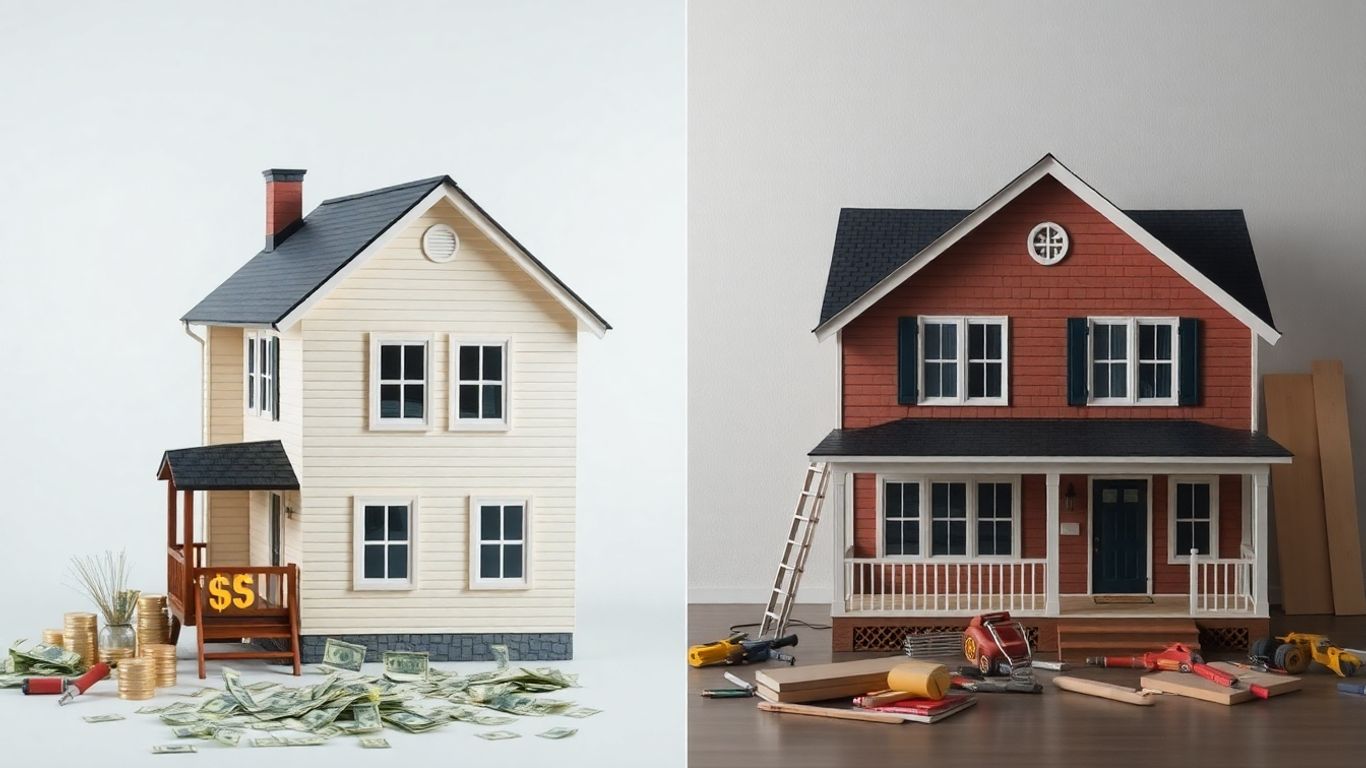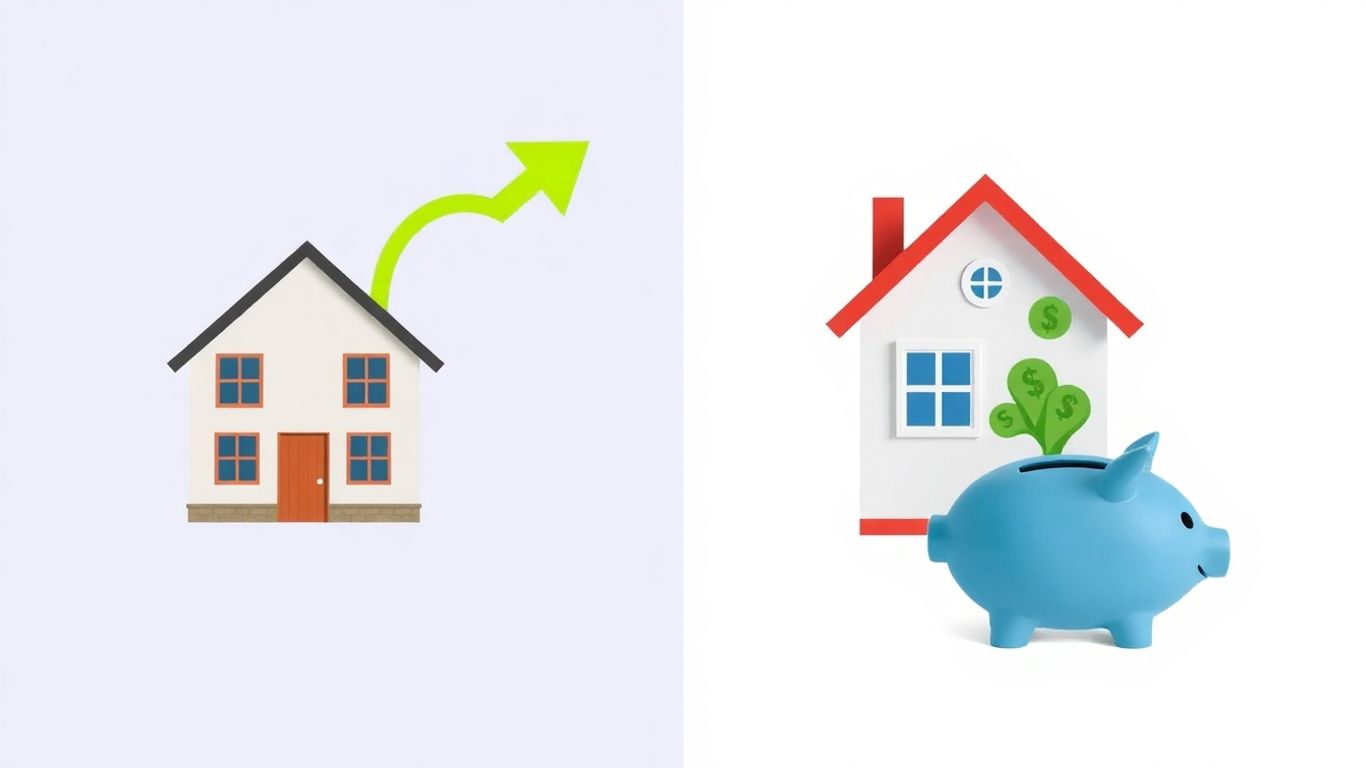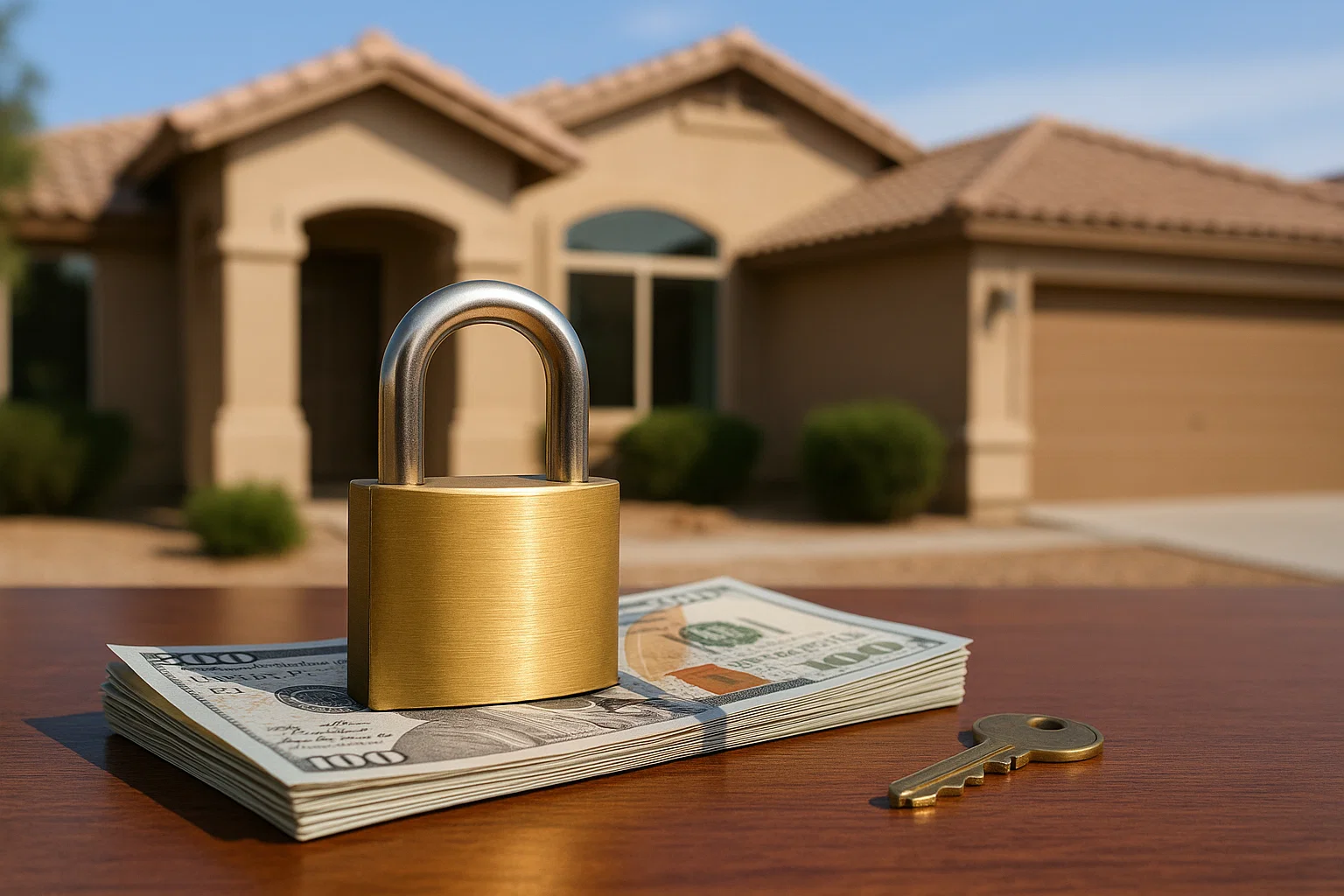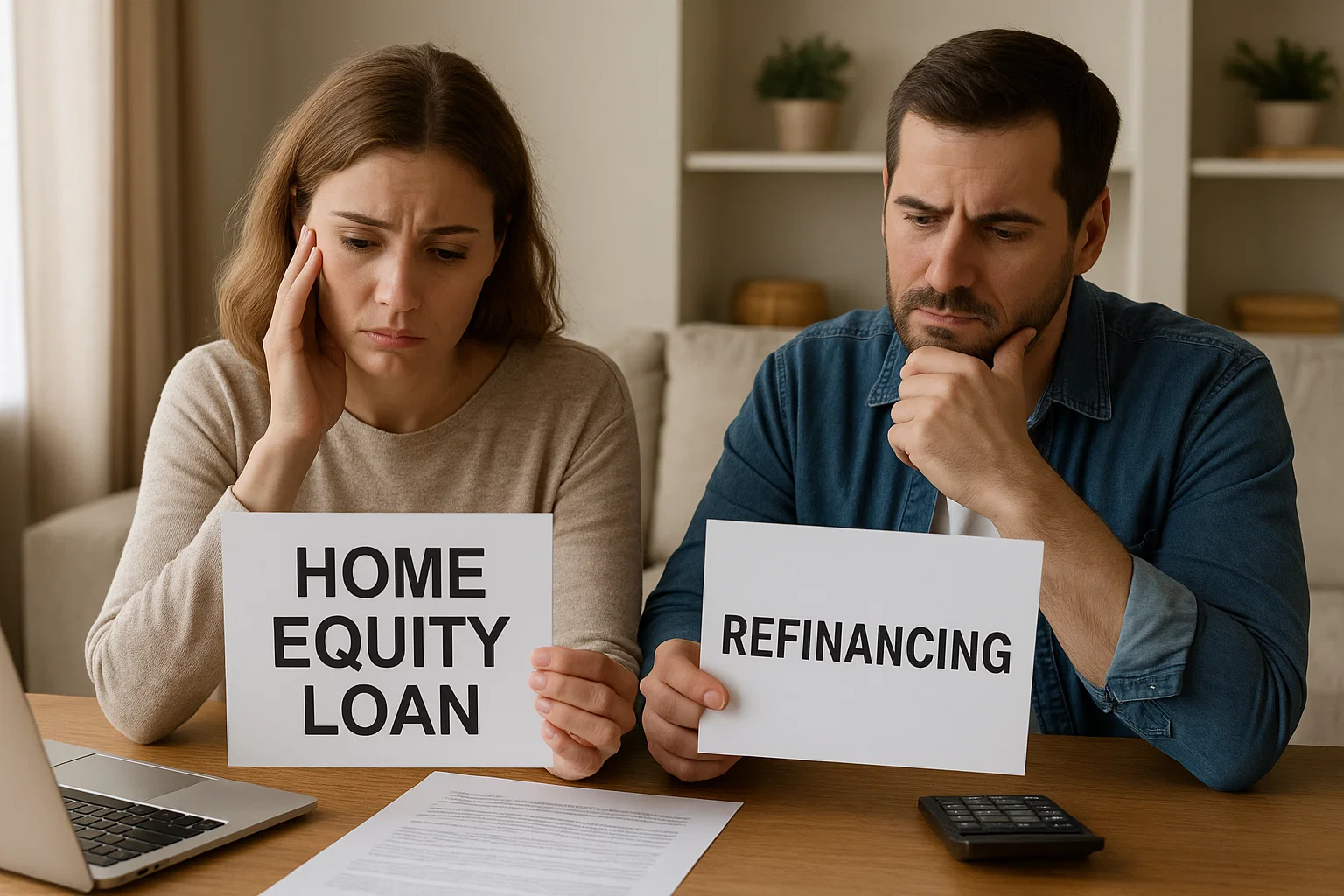Cash-Out Refinance vs. Home Equity Loan: Which is Right for Your Home Improvement Project?
November 19, 2025
Cash-out refinance vs. home equity loan: Learn the key differences to decide which is best for your home improvement project.

Thinking about fixing up your house? Maybe a new kitchen or a finished basement is on your mind. Often, homeowners tap into the equity they've built up in their homes to pay for these projects. Two common ways to do this are a cash-out refinance and a home equity loan. They sound similar, and in some ways they are, but they work differently and have different impacts on your finances. Let's break down the cash-out refinance vs home equity loan debate to help you figure out which one might be the better fit for your home improvement plans.
Key Takeaways
- A cash-out refinance replaces your current mortgage with a new, larger one, giving you the difference in cash. You'll have one new monthly payment.
- A home equity loan is a separate loan, often called a second mortgage, that you take out in addition to your existing mortgage. You'll have two separate payments.
- Cash-out refinances might offer lower interest rates because they are the primary loan, but they often come with higher closing costs and can extend your loan term.
- Home equity loans can be quicker to get and may have lower closing costs, but they typically have higher interest rates than first mortgages.
- The best choice depends on your financial situation, your current mortgage rate, how long you plan to stay in your home, and how much cash you need.
Understanding Your Home Equity Options
What is Home Equity?
Think of your home equity as the part of your home's value that you actually own. It's what's left over if you were to sell your house and pay off your mortgage. For example, if your home is worth $400,000 and you still owe $200,000 on your mortgage, you have $200,000 in equity. This equity builds up over time as you make mortgage payments and, hopefully, as your home's value increases. It's like a savings account built into your house, and sometimes you might want to tap into it for big projects or expenses.
Accessing Your Home Equity
So, you've got this equity sitting there, and you're thinking about using it. That's totally understandable, especially if you've got a home improvement project in mind or some other financial need. There are a couple of main ways people usually go about this. You can either replace your current mortgage with a new, bigger one that gives you cash back, or you can take out a separate loan that's specifically for borrowing against your home's value. Each way has its own set of rules and impacts, so it's not a one-size-fits-all situation. Choosing the right method really depends on your specific financial picture and what you're trying to achieve.
Cash-Out Refinance vs. Home Equity Loan Overview
When you're looking to borrow against your home's value, two popular routes are the cash-out refinance and the home equity loan. They sound similar, and in a way, they are because they both let you use the equity you've built up. But how they work and what they mean for your finances are quite different.
Here's a quick rundown:
- Cash-Out Refinance: This is basically getting a brand new mortgage that's larger than your current one. You pay off your old mortgage with the new loan, and the extra cash is yours to use. It means you'll have just one mortgage payment, but it will likely be for a larger amount and possibly over a longer term.
- Home Equity Loan: This is like a second mortgage. You keep your original mortgage exactly as it is, with its own payment schedule and interest rate. Then, you take out a separate loan for a fixed amount, which you pay back over time with its own payment. This gives you two separate loan payments to manage.
Deciding between these two options isn't just about getting the money; it's about how that money fits into your overall financial plan and how comfortable you are with the terms of the new borrowing. It's always a good idea to crunch the numbers for both scenarios before you commit.
Here's a simplified look at how they might compare:
The Mechanics of a Cash-Out Refinance

A cash-out refinance is basically when you get a brand new mortgage that's bigger than your current one. The extra cash you get from this new, larger loan is yours to use however you want. It's a way to tap into the equity you've built up in your home.
Replacing Your Existing Mortgage
When you do a cash-out refinance, you're not just getting a new loan; you're completely replacing your old mortgage. The lender pays off your remaining balance on your original loan, and then you start fresh with a new loan. This new loan will be for a larger amount than what you owed, and the difference is the cash you receive. Think of it like trading in your old car for a new one – you get rid of the old loan and get a new one in its place.
Receiving Cash Proceeds
After your new, larger mortgage is finalized, the lender will give you the difference between the new loan amount and what you owed on your old mortgage. This is the 'cash-out' part. For example, let's say your home is worth $400,000 and you owe $200,000 on your current mortgage. If you get approved for a new mortgage of $250,000, you'll receive $50,000 in cash after the old loan is paid off. Keep in mind, though, that there will be closing costs and fees associated with this new loan, which will reduce the actual amount of cash you walk away with.
Impact on Monthly Payments and Loan Terms
Getting a new, larger mortgage usually means your monthly payments will change. Since the new loan is bigger, your monthly payment will likely be higher than what you were paying before. Also, the loan term might be extended. This means you could be paying off your mortgage for a longer period. It's really important to look at the numbers closely to see how this affects your budget. You'll want to compare the new payment and terms to your old ones to make sure it makes financial sense for you.
It's wise to consider the costs and compare them to your current loan before refinancing. You might end up with higher monthly payments or a longer payoff period, but you could also potentially get a lower interest rate on the entire loan balance.
Exploring Home Equity Loans

A home equity loan lets you borrow against the value you’ve built up in your home without changing your existing mortgage. Think of it as a lump-sum loan, secured by your house, with fixed terms and payments. You get all the money at once, usually at a fixed interest rate, and then pay it back through regular monthly installments. If you need funds for a major project or expense—like a big kitchen upgrade or finally dealing with that leaky roof—this can be a straightforward way to tap your home’s worth without refinancing the mortgage you already have.
Second Mortgage Structure
A home equity loan is sometimes called a "second mortgage" because it sits behind your original home loan. That means:
- You keep your existing mortgage in place; nothing gets swapped out or rewritten.
- The new loan is secured by your home, but it’s a separate obligation entirely.
- If you run into major financial trouble, the lender of your first mortgage gets paid back before your home equity loan lender does if your home is sold.
Here's a quick rundown in table form:
Separate Payment Schedule
Taking out a home equity loan means you’ll have a separate monthly bill, alongside your regular mortgage payment. Here’s how that shakes out:
- Two monthly payments, two loan servicers. You’ll need to make sure you stay on top of both.
- The home equity loan typically comes with a set repayment timeline, most often 5–30 years, and no surprises—payments are fixed.
- Your original mortgage won’t change one bit, so your primary loan’s interest rate and remaining balance are untouched.
Making two payments can take some getting used to, especially if you’re juggling other bills, but some homeowners like the idea of keeping the debt for their projects separate from the mortgage they’ve worked so hard to pay down.
Sometimes, the home equity loan route simply makes more sense, especially if you locked in a really good mortgage rate or you want flexibility. Just be aware: your house is still on the line if you don’t pay, so do the math and make sure the extra payment fits your budget.
Key Differences: Cash-Out Refinance vs. Home Equity Loan
So, you've got some equity built up in your home and you're thinking about tapping into it for that big renovation project. That's great! But how do you actually get that money? Two common ways are a cash-out refinance and a home equity loan. They sound similar, and in some ways, they are, but they work quite differently, and understanding those differences is super important before you commit.
Loan Position and Interest Rates
This is a big one. A cash-out refinance essentially replaces your current mortgage with a brand new, larger one. This new loan becomes your primary mortgage, sitting in the first lien position. Because it's the first in line to be paid back if something goes wrong, lenders usually offer lower interest rates on these loans. Think of it like being first in line at the buffet – you get the best pickings. A home equity loan, on the other hand, is typically a second mortgage. It sits behind your primary mortgage. This means it's riskier for the lender, so you'll generally see higher interest rates compared to a cash-out refinance. It's like being second in line; you might not get the exact same prime cuts.
Closing Costs and Fees
Both options come with closing costs, but they can add up differently. Refinancing your entire mortgage, as you do with a cash-out refinance, usually involves more significant fees. We're talking about things like appraisal fees, title insurance, origination fees, and recording fees. These can often range from 2% to 6% of the total loan amount. A home equity loan, being a second mortgage, often has lower closing costs. They might include processing fees and an appraisal, but generally, it's less than a full refinance. If you're planning to move or sell your home relatively soon after taking out the loan, those higher closing costs on a cash-out refinance might mean you don't recoup your expenses.
Impact on Existing Mortgage
This is where the core difference lies. A cash-out refinance means you're saying goodbye to your current mortgage and hello to a new one. Your old loan is paid off, and you start fresh with a new interest rate, a new loan term, and a new monthly payment. This can be good if your current mortgage has a high interest rate and you can get a lower one now, but it also means you might reset your payoff timeline. A home equity loan, however, is a separate loan. It doesn't touch your original mortgage. You keep your existing loan with its current interest rate and payment schedule, and you add a second loan on top of it. This is particularly appealing if you have a great interest rate on your current mortgage that you don't want to lose. You'll just have two separate payments to manage each month.
When deciding, think about your current mortgage's interest rate. If it's already low, keeping it might be more beneficial than replacing it with a new loan that could have a higher rate, even if you get cash back. A home equity loan lets you preserve that favorable rate.
Here's a quick rundown:
- Cash-Out Refinance: Replaces your existing mortgage with a new, larger one. You get a lump sum of cash. You'll have one new, potentially higher, monthly payment. Interest rates are typically lower because it's a first lien. Closing costs can be higher.
- Home Equity Loan: Acts as a second mortgage, separate from your primary loan. You get a lump sum of cash. You'll have two monthly payments (your original mortgage plus the new loan). Interest rates are usually higher due to the second lien position. Closing costs are generally lower.
Choosing the right path really depends on your specific financial situation and what you want to achieve with your home improvement project. It's worth looking into the details of a cash-out refinance to see if it aligns with your goals.
When to Choose a Cash-Out Refinance
So, you've been paying down your mortgage, and maybe your home's value has gone up a bit since you bought it. That means you've got equity, which is basically the part of your home you actually own. Now you're thinking about tapping into that equity for a big project, like a kitchen remodel or maybe even consolidating some debt. A cash-out refinance could be your ticket.
Significant Home Value Appreciation
If your home has seen a pretty big jump in value since you purchased it, a cash-out refinance really starts to make sense. Think about it: your new, larger loan is based on this higher value. This means you can pull out a substantial amount of cash. It’s like your house has become a bigger piggy bank, and this is a way to crack it open.
Desire for a Single Monthly Payment
One of the biggest draws of a cash-out refinance is that it simplifies your monthly bills. Instead of juggling your original mortgage payment and then a separate payment for a home equity loan, you'll just have one new, larger mortgage payment. This can make budgeting a lot easier to manage. No more trying to remember two different due dates!
Potential for Lower Interest Rates
Because a cash-out refinance replaces your existing mortgage with a new one, it's considered a first lien position. Loans in this position often come with lower interest rates compared to second mortgages, like home equity loans. If you can snag a lower rate on the entire loan amount, you could end up saving money on interest over the life of the loan, even with the larger principal.
It's important to remember that while a cash-out refinance can be a great way to access funds, it does mean you're taking on a new, larger mortgage. You'll want to carefully compare the closing costs and the new interest rate to your current situation to make sure it's truly the best deal for you. Don't just jump in without doing the math!
Here's a quick look at what you might expect:
- New Loan Amount: Your old mortgage balance + the cash you want out + closing costs.
- Interest Rate: Potentially lower than a home equity loan, but you'll be paying it on a larger total amount.
- Monthly Payment: Likely to be higher than your current mortgage payment.
- Loan Term: You might reset the clock on your mortgage term, meaning you could be paying for a longer period.
When a Home Equity Loan is the Better Choice
Sometimes, you just want to keep things simple, right? If you've got a great interest rate on your current mortgage, maybe you got it a few years back when rates were super low, then messing with it might not be the best move. That's where a home equity loan can really shine.
Preserving Your Current Mortgage Rate
Think of your current mortgage like a comfortable old sweater. You like it, it fits well, and the price you're paying for it is just right. A cash-out refinance is like buying a whole new outfit – it might be nice, but you're ditching the old one and starting over with potentially different terms. A home equity loan, on the other hand, is like buying a new scarf to go with your sweater. You keep the sweater (your original mortgage) exactly as it is, with its familiar payment and interest rate, and just add a separate loan for the extra cash you need.
- You keep your existing mortgage rate. This is a big one if your current rate is significantly lower than what's available today.
- You'll have two separate payments. One for your original mortgage and one for the new home equity loan. This can sometimes feel like more paperwork, but it means your primary mortgage terms don't change.
- Fixed repayment terms. Home equity loans typically come with a fixed interest rate and a set repayment period, making budgeting predictable.
Shorter Application to Closing Process
Refinancing your entire mortgage can feel like a marathon. There's a lot of paperwork, appraisals, and waiting. A home equity loan is often a quicker sprint. Lenders might not require as extensive an appraisal, and the process can sometimes be streamlined because you're not replacing your primary loan.
Avoiding Extensive Refinancing Costs
Refinancing usually comes with a list of fees – appraisal fees, title insurance, origination fees, and more. These costs can add up. While a home equity loan isn't free, the associated closing costs are generally lower than those for a full refinance. If you only need a specific amount of cash and don't want to pay for a whole new mortgage process, a home equity loan can be the more cost-effective route.
When you choose a home equity loan, you're essentially taking out a second mortgage. This means you'll have two separate loan payments to manage each month. It's important to be sure you can comfortably handle both your original mortgage payment and the new home equity loan payment before you commit.
Financial Considerations for Home Improvement Projects
So, you've got big plans for your home – maybe a kitchen remodel that's been years in the making or finishing that basement to add some extra living space. That's awesome! But before you start picking out tile or dreaming of cozy movie nights, let's talk about the money side of things. Getting the funds for a big project involves looking at a few key financial aspects to make sure you're making the smartest choice for your wallet and your home.
Borrowing Limits and Loan-to-Value Ratio
Lenders look at something called the Loan-to-Value (LTV) ratio. Basically, it's the amount you owe on your mortgage compared to the current market value of your home. Most lenders won't let you borrow more than a certain percentage of your home's value, often around 80% to 90% when you combine your existing mortgage and any new loan. So, if your home is worth $400,000 and you owe $200,000, your current LTV is 50%. If a lender allows up to 80% LTV, you could potentially borrow up to $320,000 ($400,000 * 0.80). This means the amount you can borrow for your project is directly tied to how much equity you have and the lender's LTV limits.
Here's a quick look at how LTV works:
Debt-to-Income Ratio Requirements
Another big factor lenders consider is your Debt-to-Income (DTI) ratio. This is a comparison of your total monthly debt payments (like car loans, student loans, credit cards, and your mortgage) to your gross monthly income (your income before taxes). Lenders use DTI to gauge how much of your income is already spoken for by debts. A lower DTI generally means you have more financial flexibility and are less of a risk. For home improvement loans, lenders often prefer a DTI of 43% or lower, though this can vary. They want to see that you can comfortably handle the new loan payment on top of your existing financial obligations.
Using Funds for Home Improvements
When you take out a cash-out refinance or a home equity loan, the money you receive is typically yours to use as you see fit. However, when you specifically state the funds are for home improvements, it can sometimes come with certain benefits or documentation requirements. For instance, some lenders might want to see project bids or permits. It's also worth noting that home improvements can potentially increase your home's value, which in turn increases your equity. This can be a smart move long-term, as you're investing in an asset that could appreciate over time.
It's really important to be honest with yourself about what you can afford. Just because you can borrow a certain amount doesn't mean you should. Think about the long haul and how this new debt will fit into your life for years to come. A shiny new kitchen is great, but not if it means stressing about bills every month.
So, Which Path Will You Take?
Deciding between a cash-out refinance and a home equity loan for your home improvement project really comes down to what makes the most sense for your wallet and your plans. If you're looking to simplify things with one single mortgage payment and maybe snag a lower interest rate on your whole loan, a cash-out refi could be your ticket. But, if you've got a sweet deal on your current mortgage and just need some extra cash without touching that first loan, a home equity loan might be the way to go. Whichever you pick, just make sure you're comfortable with the payments and that it truly helps you reach your goals. Putting your home on the line is a big deal, so weigh those options carefully before you make your move.
Frequently Asked Questions
What's the main difference between a cash-out refinance and a home equity loan?
Think of it like this: a cash-out refinance swaps your old mortgage for a brand new, bigger one. You pay off the old loan and get the extra cash. A home equity loan is like a separate loan, a second mortgage, that sits alongside your original one. You get a lump sum from this second loan.
Which option usually has a better interest rate?
Generally, cash-out refinances tend to offer lower interest rates. This is because they become the primary loan on your house, meaning they get paid back first if something goes wrong. Home equity loans, being a second loan, often come with slightly higher rates.
What are closing costs like for each option?
Cash-out refinances usually involve higher closing costs, often a percentage of the loan amount. Home equity loans typically have lower closing costs, and sometimes lenders even cover them.
When is a cash-out refinance a better choice?
A cash-out refinance makes sense if your home's value has gone up a lot, you want just one single monthly payment for your mortgage, and you think you can get a better interest rate than your current one. It's also good if you plan to stay in your home for a while to make the most of the closing costs.
When might a home equity loan be the smarter move?
A home equity loan is often better if you have a great interest rate on your current mortgage that you don't want to lose. It's also quicker to get approved and closed, and you avoid the big closing costs of a full refinance. Plus, it's good if you don't plan on staying in your home for many more years.
Can I use the money from either option for anything I want?
Yes, the cash you get from either a cash-out refinance or a home equity loan is yours to use as you please. Many people use it for home improvements, but you could also use it for debt consolidation, education costs, or other major expenses.













Get in touch with a loan officer
Our dedicated loan officers are here to guide you through every step of the home buying process, ensuring you find the perfect mortgage solution tailored to your needs.
Options
Exercising Options
Selling
Quarterly estimates
Loans
New home

Stay always updated on insightful articles and guides.
Every Monday, you'll get an article or a guide that will help you be more present, focused and productive in your work and personal life.









.png)
.png)
.png)
.png)
.png)
.png)
.png)
.png)
.png)
.png)
.png)
.png)
.png)
.png)
.png)
.png)
.png)
.png)